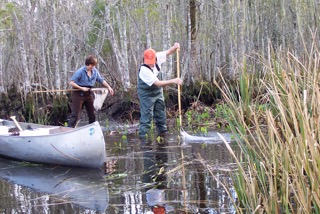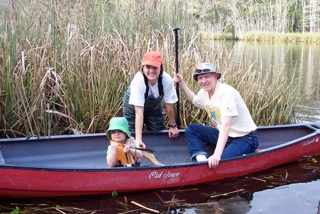
The color polymorphism in bluefin killifish – males display anal fins in blue, red, or yellow.
The activities are as follows:
- Teacher Guide
- Student activity, Graph Type A, Level 4
- Student activity, Graph Type B, Level 4
- Student activity, Graph Type C, Level 4
- Reading Activity
- Grading Rubric
In nature, animals can be found in a dazzling display of different colors and patterns. Color patterns serve as signals to members of the animal’s own species, or to other species. They can be used to attract mates, camouflage with the environment, or warn predators to stay away. When looking at the diversity of colors found in nature, you may wonder, why do animals have the color patterns they do? One way to study this question is to look at a single species that has individuals of different colors. This variation can be used to uncover the mechanisms that determine color.
The bluefin killifish is a freshwater species that is found mostly in Florida. They are found in two main habitats, springs and swamps. An intriguing aspect of this species is that male bluefin killifish are brightly colored with many different color patterns. The brightest part of the fish is the anal fin, which is found on the bottom of the fish by the tail. Some males have red anal fins, some have yellow anal fins, and others have blue anal fins. This variation in color is called a polymorphism, meaning that in a species there are multiple forms of a single trait. In a single spring or swamp you may see all three colors!

Becky in the field, with her colleague Katy, collecting fish in 26 Mile Bend Swamp.
Becky is a biologist studying bluefin killifish. One day, while out snorkeling for her research, she noticed an interesting pattern. She observed that there were differences in the polymorphism depending on whether she was in a spring or swamp. Springs have crystal clear water that can appear blue-tinted. Becky noticed that most of the males in springs had either red or yellow anal fins. Swamps have brown water, the color of iced tea, due to the dissolved plant materials in the water. Becky noticed that most of the males in swamps had blue anal fins. After noticing this pattern she wanted to find out why this variation in color existed. Becky came up with two possible explanations. She thought males in swamps might be more likely to be blue (1) because of the genes they inherit from their parents, or (2) because individual color is responding to environmental conditions. This second case, where the expression of a trait is directly influenced by the environment that an individual experiences, is known as phenotypic plasticity.
Becky had to design an experiment that could tease apart whether genes, plasticity, or both were responsible for male anal fin color. She did this by collecting male and female fish from the two habitat types, breeding them, and raising their offspring in clear or brown water. If a father’s genes are responsible for anal fin color in their sons, then fathers from swamps would be more likely to leave behind blue sons. If environmental conditions determine the color of sons, then sons raised in brown water will be blue, regardless of the population origin of their father.

Becky’s family helping her out in the field!
Becky and her colleagues collected fish from two populations in the wild – Wakulla Spring, and 26 Mile Bend Swamp – and brought them into the lab. These two populations represent the genetic stocks for the experiment. Fish from Wakulla are more closely related to each other than they are to fish from 26 Mile Bend. In the lab, they mated female fish with male fish from the same population: females from Wakulla mated with males from Wakulla, and females from 26 MB mated with males from 26 MB. The female fish then laid eggs, and after the offspring hatched from their eggs, half were put into tanks with clear water (which mimics spring conditions) and half in tanks with brown water (which mimics swamp conditions). For the brown water treatment, Becky colored the water using ‘Instant, De-caffeinated, No-Sugar, No-Lemon’ tea. They raised the fish to adulthood (3-6 months) so they could determine their sex and the color of the son’s anal fins. Becky then counted the total number of male offspring, and the number of male offspring that had blue anal fins. She used these numbers to calculate the proportion of sons that had blue anal fins in each treatment.
Featured scientist: Becky Fuller from The University of Illinois
Flesch–Kincaid Reading Grade Level = 9.4
To introduce students to bluefin killifish, there is a video showing the blue and red color morphs. Video can be shown on mute (background music is a little corny)!
About Becky: I consider myself to be an evolutionary biologist who studies fishes. I grew up in a small town riding horses in 4-H and working in a veterinary clinic. As an undergraduate at the University of Nebraska at Lincoln, I was interested in biology and considering either medical or veterinary school. Two things led to me research in ecology and evolution. In the summer of 1991, I was taking courses at Cedar Point Biological Field Station which was run by the University of Nebraska. I met Dr. Anthony Joern (Tony) who was studying grasshopper community ecology. Tony hired me onto his field crew that summer after the courses were finished. I went on to do an undergraduate thesis under Tony’s mentorship where I studied predation on grasshoppers. I caught the “science bug” and never looked back. Following my undergraduate work, I went to Uppsala University in Sweden on a Fulbright Scholarship. Here, I developed my love for fish and aquatics. I worked with Dr. Anders Berglund on pipefish in a fjord on the west coast of Sweden. Since then, I have had many wonderful advisers, instructors, mentors, and collaborators who have helped me develop skills along the numerous fronts required for a successful career in science. I consider myself very fortunate to have a job where I can do science and teach young, enthusiastic undergraduates.


Hi,
I’m looking for the student versions of “Why so blue?” and they aren’t available. I’d love to use this activity if they are available.
Thanks!